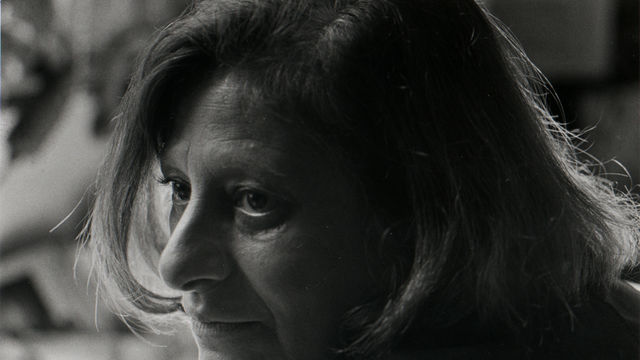
Diana Dowek
Born in 1942, the Argentine painter Diana Dowek was thirteen years old when she entered the Escuela de Bellas Artes Manuel Belgrano in Buenos Aires; she later studied at the Escuela Nacional de Bellas Artes Prilidiano Pueyrredón in Buenos Aires. From a very young age she participated in activist youth groups, such as the Movimiento Estudiantil de Unidad Reformista, to which she belonged from 1956 to 1957. During the 1960s the political tenor of her paintings became increasingly apparent. In one of her first series, focused on the Vietnam War, she denounced the abuses and injustices perpetrated by national governments. Influenced by the realist paintings of the Argentine artist Antonio Berni (1905–1981) and her studies in cinema, which she embarked on while in Italy in 1964, Dowek began to approach painting as a mise-en-scène charged with metaphoric meaning.
From the tumultuous decade of the 1970s three of her series stand out: Retrovisores (Mirrors), Paisajes (Landscapes), and Alambrados (Barbed wire). For instance, the Paisajes canvases were painted as if from within a car, with the rearview mirror reflecting some ominous detail referring to the military's use of kidnapping and murder. In 1977 Dowek turned to the symbolism of barbed wire in her series Alambrados to connote the systematic disappearance of thousands of Argentines by the military regime. Barbed wire alluded to worsening conditions yet offered a glimpse of hope through openings in the wire to suggest an escape to freedom. In the mid-1980s, after the end of the dictatorship, Dowek turned her attention to representing wounds sutured by surgical thread, which closely resembled the wire used in her paintings from the 1970s. In the series Una larga marcha (A long march, 2002–6), Dowek offers a meditation on a different type of absenteeism: sleep. Situated in the context of the collapse of the Argentine economy in 2001, these are portraits of protesters sleeping on the streets of Buenos Aires. Most recently, she has been the recipient of the Premio a la Trayectoria en Pintura (2013), granted by the Fondo Nacional de las Artes, and the Primer Premio de Pintura (2011), given by the Banco Central de la República Argentina, among several other awards. Twice she has received grants from the Pollock-Krasner Foundation in the United States (1995, 2001). Dowek lives and works in Buenos Aires, where she continues to paint and is deeply committed to human rights issues.
—Marcela Guerrero
Selected Solo Exhibitions
1968 Galería Lirolay, Buenos Aires
1985 Pintado en Argentina, Museo Eduardo Sívori, Centro Cultural de Buenos Aires
1996 Zona Catástrofe: El poder vulnerable, Fundación Federico Klemm, Buenos Aires
2001 Diana Dowek: Exposición retrospectiva, 1972–2000, Museo Nacional de Bellas Artes, Buenos Aires
2013 La pintura es un campo de batalla, Museo Nacional de Bellas Artes, Neuquén, Argentina
Selected Bibliography
Bell, Vikki. "Absence and Vigilance: The Artwork of Diana Dowek and Lucila Quieto." In The Art of Post-dictatorship: Ethics and Aesthetics in Transitional Argentina, 119–33. New York: Routledge, 2014.
Diana Dowek: Exposición retrospectiva, 1972–2000. Buenos Aires: Museo Nacional de Bellas Artes, 2001.
Diana Dowek: Fragmentos de una historia inconclusa, 1972–2005. Buenos Aires: Fondo Nacional de las Artes, 2005.
Diana Dowek: La pintura es un campo de batalla; Obras, intervenciones, 1967–2012. Buenos Aires: Asunto Impreso, 2013.
Glusberg, Jorge. La postfiguracion: Homenaje a Antonio Berni; Burton, Dowek, Gómez, Sbernini, Soibelman. Buenos Aires: Museo de Arte Moderno, 1982.


